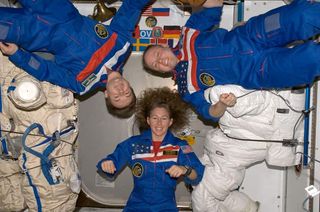What Are 3 Possibilities Astronauts Have to Start the Engines Again
Station Astronauts Take Shelter from Space Debris

This story was updated at 2:18 p.m. EDT.
Astronauts aboard the International Infinite Station took refuge within their Russian-built Soyuz lifeboat Thursday when a potentially life-threatening slice of infinite droppings zipped too close to their orbiting laboratory.
The iii astronauts, two Americans and ane Russian, moved into the station'due south attached Soyuz TMA-13 spacecraft at 12:35 p.m. EDT (1635 GMT) as a safety precaution in case the debris — a pocket-size piece of a spent satellite motor — slammed into the orbiting lab and ripped a hole in its outer hull. The astronauts were set to evacuate the space station if the debris hit the station and depressurized its living infinite.
Discover of the incoming droppings came overnight, too tardily for flight controllers to program a maneuver to fire the station's thrusters and put more than infinite between it and the space trash, NASA officials said. Only the debris apparently did not impact the $100 billion orbiting lab as information technology flew 220 miles (354 km) higher up Earth.
"We're all happy the [debris] passed with no impact," NASA's Mission Control radioed up to the coiffure from the Johnson Infinite Center (JSC) in Houston. "That's great news."
NASA spokesperson Brandi Dean at JSC told Infinite.com that the astronauts did not fully close the hatches betwixt the Soyuz and the balance of the space station during the precaution, but they were prepared to do then if required. The satellite motor remnant was expected to zoom past the station at a distance of about 2.4 miles (4 km), Dean said.
"The closure of the hatches ensures the safety of the coiffure and the ability to quickly depart the station in the unlikely event the debris collided with the station causing a depressurization," NASA officials said. "Moving the crew into the Soyuz is a precaution, every bit the probability of impact is low."
Space station commander Michael Fincke and flight engineer Sandra Magnus, both of NASA, and Russian cosmonaut Yury Lonchakov told Mission Control that they could not see the infinite debris, but were glad it missed the infinite station.
"Sandy kept her eyes out the Soyuz windows and nosotros didn't see annihilation, of form," Fincke radioed down to Mission Control. "Merely we were wondering how shut things were. We'd be interested in that."
Space debris threat
Dean said NASA flight controllers are refining their estimates to how shut the debris came to the space station.
The wayward satellite motor part came from an outdated PAM-D rocket engine that was once used to boost a satellite from low-Earth orbit a few hundred miles above Earth out to a geosynchronous position about 22,300 miles (36,000 km) to a higher place the planet. The debris was small, just 1/3 of an inch long, and was flying at most 19,800 mph, NASA officials said. The space station orbits the Earth at almost 17,500 mph.
The space station has fired its Russian rocket engines to avoid infinite junk before, and astronauts have sought shelter in their attached Soyuz spacecraft - which doubles as a lifeboat in emergencies - at least once earlier, she added.
"It has happened earlier," Dean said.
The last fourth dimension astronauts sought refuge from infinite debris in their Soyuz spacecraft was on Nov. 17, 2008, when the remains of an quondam SL-12 rocket flew within 12 miles (nineteen km) of the space station, according to the European Space Agency. That debris event also did not bear on the space station.
The satellite motor made its closest laissez passer by the space station at 12:39 p.m. EDT (1639 GMT). By 12:46 p.m. EDT (1646 GMT), Fincke and his fellow crewmates were given the all clear to reenter the space station.
Space debris has been a growing threat for spacecraft in depression-Earth orbit.
NASA officials said the recent February. ten collision between a Russian military satellite and a U.Southward. communications satellite has increased the gamble of debris impacts during a space shuttle mission by about six percent.
The unprecedented February. ten standoff occurred 490 miles (790 km) above Siberia and created ii large clouds of droppings in World orbit. Some of the debris particles are expected to start re-entering the Earth'south atmosphere this week.
Join our Space Forums to keep talking space on the latest missions, nighttime sky and more! And if y'all have a news tip, correction or comment, let us know at: community@space.com.
Source: https://www.space.com/6410-station-astronauts-shelter-space-debris.html

0 Response to "What Are 3 Possibilities Astronauts Have to Start the Engines Again"
Post a Comment